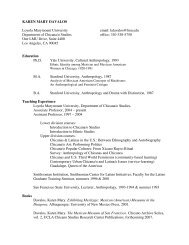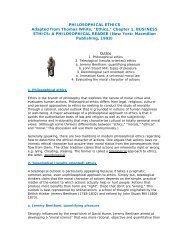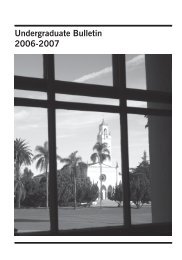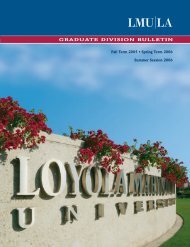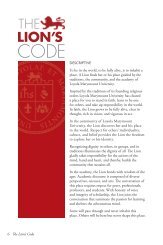55332 2005 Program.indd - Loyola Marymount University
55332 2005 Program.indd - Loyola Marymount University
55332 2005 Program.indd - Loyola Marymount University
Create successful ePaper yourself
Turn your PDF publications into a flip-book with our unique Google optimized e-Paper software.
The academic gown was modified from the<br />
ecclesiastic robes that the medieval clergy wore<br />
to class. The common practice was codified<br />
at Oxford in 1222 when the Archbishop of<br />
Canterbury mandated the wearing of the<br />
cappa clausa, a closed robe based, like the<br />
pileus quadralus, on a lay style. The tradition<br />
of a specifically academic robe spread to Paris,<br />
Bologna, and throughout Europe over the next<br />
centuries, although most universities in Germany<br />
and Switzerland did not adopt the practice.<br />
Today, individual European universities continue<br />
to establish their own academic costumes. <strong>Loyola</strong><br />
<strong>Marymount</strong> <strong>University</strong> faculty who attended<br />
international institutions proudly wear their unique<br />
and colorful attire to our commencement ceremony.<br />
The traditions of British academic regalia<br />
naturally carried over into most American<br />
institutions, but gradually gave way to the wearing<br />
of lay fashions in class. It was in the later part of<br />
the nineteenth century that students at Columbia,<br />
Bryn Mawr, and several other institutions sought<br />
to revive the European tradition, at least for<br />
use at commencement ceremonies. In 1895, a<br />
special inter-collegiate commission standardized<br />
a specifically American style and form to<br />
commencement costumes. Subsequently, in 1932<br />
and again in 1959, this code was revised and<br />
appropriate styles and colors prescribed to meet<br />
the needs of the burgeoning academic institutions<br />
of this country. But with only subtle differences,<br />
nearly all American students graduate in the same<br />
caps, hoods, and gowns.<br />
Styling of the robes varies slightly for the<br />
bachelor’s, master’s, and doctoral degrees, but<br />
a somber black is the American standard color.<br />
Hoods corresponding to individual majors also<br />
differ in length, trim, and shape. The hood lining<br />
designates the colors of the institution granting<br />
it, hence the <strong>Loyola</strong> <strong>Marymount</strong> hood is lined in<br />
crimson and blue. The color of the velvet border<br />
on the hood designates the major of the graduate’s<br />
degree, corresponding with the following scheme:<br />
15<br />
White<br />
Copper<br />
Scarlet<br />
Drab<br />
Brown<br />
Silver<br />
Bright Gold<br />
Gold<br />
Orange<br />
Crimson<br />
African American Studies<br />
Art History<br />
Asian and Pacific Studies<br />
Chicana/o Studies<br />
Classical Civilizations<br />
Classics<br />
Counseling Psychology<br />
English<br />
European Studies<br />
French<br />
Greek<br />
History<br />
Humanities<br />
Latin<br />
Liberal Studies<br />
Marital and Family Therapy<br />
Pastoral Studies<br />
Philosophy<br />
Political Science<br />
Psychology<br />
Sociology<br />
Spanish<br />
Urban Studies<br />
Economics<br />
Theology<br />
Accounting<br />
Business Administration<br />
Dance<br />
Studio Arts<br />
Theatre Arts<br />
Communication Studies<br />
Applied Mathematics<br />
Athletic Training<br />
Biology<br />
Chemistry<br />
Computer Science<br />
Engineering & Production Management<br />
Engineering Physics<br />
Environmental Science<br />
Mathematics<br />
Natural Science<br />
Physics<br />
Biochemistry<br />
Civil Engineering<br />
Electrical Engineering<br />
Mechanical Engineering<br />
Animation<br />
Film Production<br />
Recording Arts<br />
Screenwriting<br />
Television Production<br />
Light Blue<br />
Education



